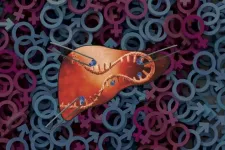(Press-News.org) ROCHESTER, Minn. -- Did you know multiple sclerosis (MS) means multiple scars? New research shows that the brain and spinal cord scars in people with MS may offer clues to why they developprogressive disability but those with related diseases where the immune system attacks the central nervous system do not.
In a study published in Neurology, Mayo Clinic researchers and colleagues assessed if inflammation leads to permanent scarring in these three diseases:
MS.
Aquaporin-4 antibody positive neuromyelitis optica spectrum disorder (AQP4-NMOSD).
Myelin oligodendrocyte glycoprotein antibody associated disorder (MOGAD).
They also studied whether scarring may be a reason for the absence of slow progressive disability in AQP4-NMOSD and MOGAD, compared with MS.
"The differences in scarring that we found will help physicians distinguish these three diseases more easily to aid in diagnosis," says Eoin Flanagan, M.B., B.Ch., a Mayo Clinic neurologist and senior author of the study. "More importantly, our findings improve our understanding of the mechanisms of nerve damage in these three diseases and may suggest an important role of such scars in the development of long-term disability in MS."
In all three of these diseases, the body's immune system targets the myelin, the insulation around nerves. This causes inflammation and leads to removal of myelin, called demyelination, within the brain and spinal cord. Visual problems, numbness, weakness, or bowel or bladder dysfunction are common symptoms. Areas of demyelination, known as lesions, appear as white spots on an MRI. The repair mechanisms within the body try to reinsulate the nerves and repair the lesions, but this may be incomplete, leading to a scar that remains visible on future MRIs. Just like an electrical cable without its insulation, this scar may leave nerve fibers vulnerable to further damage and to degenerate over time.
The study included 156 patients, consisting of 67 patients with MS; AQP4-NMOSD, 51; and MOGAD, 38. These patients had172 attacks, or relapses, combined.
With MS, the researchers found that areas of inflammation reduced only modestly in size and led to a moderately sized scar. When scars are in regions of the brain and spinal cord that control arm and leg muscles, nerve fibers can degenerate and lead to slow worsening of disability in the secondary progressive course of MS.
"Our study highlights the importance of the currently available MS medications that very effectively can prevent attacks, new lesions and subsequent scar formation" says Elia Sechi, M.D., a former Mayo Clinic fellow and first author of the study. Dr. Sechi is now at the University of Sassari in Sardinia, Italy.
But AQP4-NMOSD and MOGAD are different from MS in that they do not have the same slow worsening of disability typical of the progressive course in MS.
With AQP4-NMOSD, large areas of inflammation occur during attacks, which often results in severe symptoms. Scars are common, but they tend to be smaller and in less important locations than in MS. Thus, less long-term problems result from those scars.
With MOGAD, despite having large areas of inflammation during an attack, the researchers found lesions tended to disappear completely over time and not leave any scar. This fits well with the excellent recovery from episodes and overall good long-term prognosis without the slow worsening disability seen in MS.
The reasons behind this recovery are not clear, the researchers note. It may suggest an enhanced ability to put the covering back onto nerves, or remyelination.
"We hope that the improved understanding on the ways MOGAD repairs its lesions so well may lead to novel treatment avenues to prevent scar formation in MS," Dr. Flanagan says.
INFORMATION:
Other Mayo Clinic researchers involved in this study are Karl Krecke, M.D.; Steven Messina, M.D.; Sean Pittock, M.D.; John Chen, M.D., Ph.D.; Brian Weinshenker, M.D.; A. Sebastian Lopez Chiriboga, M.D.; Claudia Lucchinetti, M.D.; Nicholas Zalewski, M.D.; Jan-Mendelt Tillema, M.D.; Amy Kunchok, M.D.; Padraig Morris, M.B. B.Ch.; James Fryer; Adam Nguyen; Tammy Greenwood; Stephanie Syc-Mazurek, M.D., Ph.D.; and B. Mark Keegan, M.D. Marina Buciuc, M.D., formerly of Mayo Clinic and now of Medical University of South Carolina in Charleston, and Salvatore Monaco, M.D., University of Verona, also contributed.
This research was funded by the Gianesini Research Grant from UniCredit Foundation and University of Verona, Mayo Clinic Center for Multiple Sclerosis and Autoimmune Neurology, and the National Institute of Health's National Institute of Neurological Disorders and Stroke (R01NS113828).
Dr. Flanagan reports research support as a site principal investigator in a randomized placebo-controlled clinical trial of inebilizumab, a CD19 inhibitor, in neuromyelitis optica spectrum disorders funded by AstraZeneca and Horizon Therapeutics.
About Mayo Clinic
Mayo Clinic is a nonprofit organization committed to innovation in clinical practice, education and research, and providing compassion, expertise and answers to everyone who needs healing. Visit the Mayo Clinic News Network for additional Mayo Clinic news. For information on COVID-19, including Mayo Clinic's Coronavirus Map tracking tool, which has 14-day forecasting on COVID-19 trends, visit the Mayo Clinic COVID-19 Resource Center.
Media contact:
Susan Barber Lindquist, Mayo Clinic Public Affairs, newsbureau@mayo.edu
For decades, researchers around the world have searched for ways to use solar power to generate the key reaction for producing hydrogen as a clean energy source -- splitting water molecules to form hydrogen and oxygen. However, such efforts have mostly failed because doing it well was too costly, and trying to do it at a low cost led to poor performance.
Now, researchers from The University of Texas at Austin have found a low-cost way to solve one half of the equation, using sunlight to efficiently split off oxygen molecules from water. The finding, published recently in Nature Communications, represents a step forward toward greater adoption ...
GAINESVILLE, Fla. --- Plants are DNA hoarders. Adhering to the maxim of never throwing anything out that might be useful later, they often duplicate their entire genome and hang on to the added genetic baggage. All those extra genes are then free to mutate and produce new physical traits, hastening the tempo of evolution.
A new study shows that such duplication events have been vitally important throughout the evolutionary history of gymnosperms, a diverse group of seed plants that includes pines, cypresses, sequoias, ginkgos and cycads. Published today in Nature Plants, the research indicates that ...
FINDINGS
A chemical modification that occurs in some RNA molecules as they carry genetic instructions from DNA to cells' protein-making machinery may offer protection against non-alcoholic fatty liver, a condition that results from a build-up of fat in the liver and can lead to advanced liver disease, according to a new study by UCLA researchers.
The study, conducted in mice, also suggests that this modification -- known as m6A, in which a methyl group attaches to an RNA chain -- may occur at a different rate in females than it does in males, potentially explaining why females tend to have higher fat content in the liver. The researchers found that without the m6A modification, differences in liver fat content between the sexes were reduced dramatically.
In ...
WOODS HOLE, Mass. - What's a hungry marine microbe to do when the pickings are slim? It must capture nutrients - nitrogen, phosphorus, or iron - to survive, yet in vast expanses of the ocean, nutrients are extremely scarce. And the stakes are high: Marine microbial communities drive many of the elemental cycles that sustain all life on Earth.
One ingenious solution to this challenge is reported this week in Proceedings of the National Academy of Sciences. In low-nutrient environments, marine microbes can clump together and hook up with even tinier cells that have vibrating, hairlike appendages (cilia) on their surface. ...
New York, NY--July 19, 2021-- A new robotic neck brace from researchers at Columbia Engineering and their colleagues at Columbia's Department of Otolaryngology may help doctors analyze the impact of cancer treatments on the neck mobility of patients and guide their recovery.
Head and neck cancer was the seventh most common cancer worldwide in 2018, with 890,000 new cases and 450,000 deaths, accounting for 3% of all cancers and more than 1.5% of all cancer deaths in the United States. Such cancer can spread to lymph nodes in the neck, as well as other organs in the body. Surgically removing lymph nodes in the neck can help doctors investigate the risk of spread, but may result in pain and stiffness in the shoulders and neck for years afterward.
Identifying ...
CT scans for patients with concussion provide critical information about their risk for long-term impairment and potential to make a complete recovery - findings that underscore the need for physician follow-up.
In a study led by UC San Francisco, researchers looked at the CT scans of 1,935 patients, ages 17 and over, whose neurological exams met criteria for concussion, or mild traumatic brain injury (TBI), at hospitals throughout the nation. While links between CT imaging features and outcome have already been established in moderate and severe TBI, the researchers believe this is the first time the link has been identified in patients ...
Hamilton, ON (July 19, 2021) - A potentially game-changing treatment for people with, or at risk of, blood clots has been found effective by an international team of researchers led by McMaster University's Jeffrey Weitz.
Weitz's team compared abelacimab with enoxaparin as a control drug in 412 patients undergoing knee replacement surgery. Results showed that just one abelacimab injection prevents blood clots for up to a month after surgery, reducing the risk by about 80% compared with enoxaparin without increasing the risk of bleeding.
Their findings were published in the New England Journal of Medicine today, coinciding with Weitz's presentation of the research at the International Society on Thrombosis and Hemostasis 2021 Congress.
Weitz, a hematologist, is a professor of medicine ...
What The Study Did: This study investigated the association between time spent cycling and the risk of death from cardiovascular disease or any other cause among people with diabetes.
Authors: Mathias Ried-Larsen, Ph.D., of Rigshospitalet in Copenhagen, is the corresponding author.
To access the embargoed study: Visit our For The Media website at this link https://media.jamanetwork.com/
(doi:10.1001/jamainternmed.2021.3836)
Editor's Note: The article includes conflicts of interest and funding/support disclosures. Please see the article for additional information, including other authors, author contributions and affiliations, conflict of interest and financial disclosures, and funding and support.
# # #
Media advisory: The full study and editor's note are ...
What The Study Did: The experiences, perspectives and needs of transgender young people in accessing health care are described in this review of 91 studies.
Authors: Lauren S. H. Chong, M.D., of the Children's Hospital at Westmead in Sydney, Australia, is the corresponding author.
To access the embargoed study: Visit our For The Media website at this link https://media.jamanetwork.com/
(doi:10.1001/jamapediatrics.2021.2061)
Editor's Note: The article includes conflict of interest disclosures. Please see the article for additional information, including other authors, author contributions and affiliations, conflict of interest and financial disclosures, and funding and support.
# ...
What The Study Did: These results suggest that substantial proportions of Latinx immigrants have immigration concerns about engaging in COVID-19-related testing, treatment and contact tracing.
Authors: Carol L. Galletly, J.D., Ph.D., Medical College of Wisconsin in Milwaukee, is the corresponding author.
To access the embargoed study: Visit our For The Media website at this link https://media.jamanetwork.com/
(doi:10.1001/jamanetworkopen.2021.17049)
Editor's Note: The article includes conflict of interest and funding/support disclosures. Please see the article for additional information, including other authors, author contributions and affiliations, conflict of interest and financial disclosures, and funding and support.
# # ...



